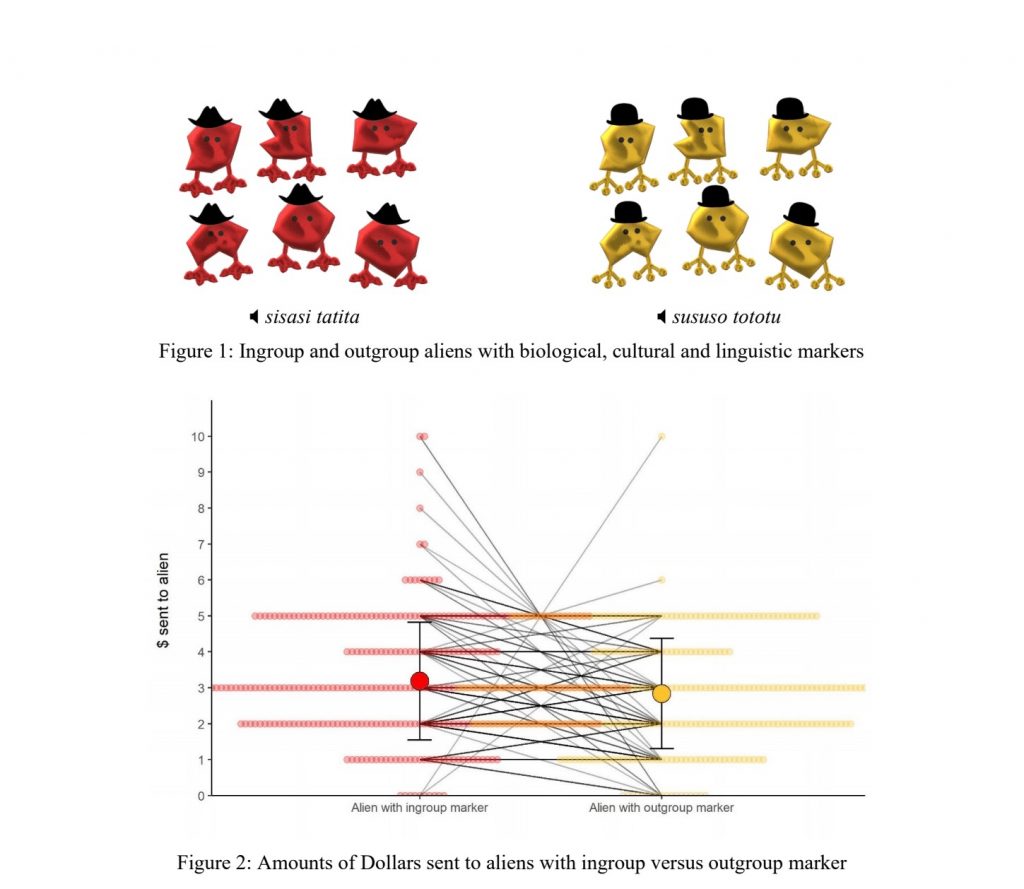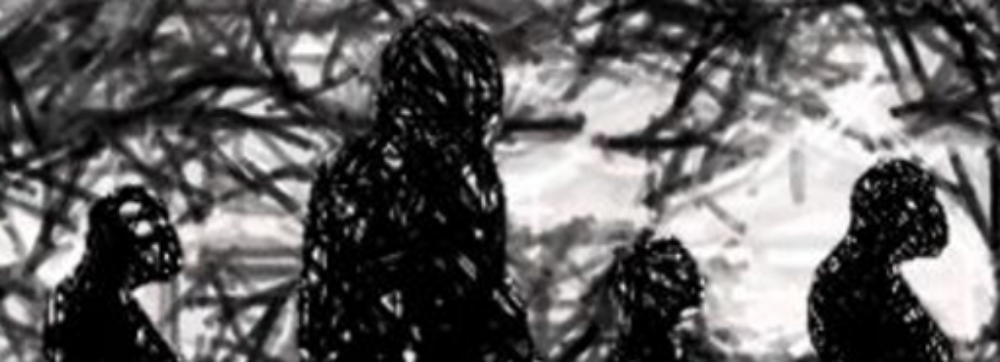Magdalena Schwarz, Theresa Matzinger and Nikolaus Ritt
Keywords: artificial language, trust game, social marker, linguistic variation, cultural evolution, sociolinguistics
A crucial quality to assess in strangers is trustworthiness. We tend to trust ingroup members more than outgroup individuals [1, 2], but the identification of group members requires reliable markers of group membership. It is debated which biological or cultural tags – including linguistic markers – meet these criteria [3]. Linguistic tags may have played a role in the evolution of trust and cooperation in humans [3, 4], and artificial language experiments have shown that linguistic variation can still function as a marker of group membership today [5, 6]. However, linguistic cues can be faked [7], and a large-scale study did not find a link between shared dialect and trust [8].
We investigate (a) whether listeners trust speakers who share their language more than those who speak a different language, and (b) how language compares in this respect to other cultural and biological markers of group membership. To address these questions, we combine two established experimental methods, trustgames [9] and artificial languages [10].
In an online experiment, participants (n=320) entered a fictional alien universe. They assumed the role of a red-coloured alien that lives on a planet with other red and yellow aliens. Each of the two alien groups exhibited three types of markers: distinct artificial languages, feet, and hats (Figure 1). After familiarisation with these aliens, participants played a simultaneous trust game with two aliens who appeared to be two other participants but were actually bots. The colours of these aliens were masked in darkness. There were three experimental conditions: in the language-condition, one of the aliens spoke the same language as the participant, while the other alien spoke the outgroup language. The foot-condition and the hat-condition were set up analogously, with one alien carrying the ingroup and the other alien the outgroup marker. The trust game largely followed the standard procedure: participants received an endowment of 10$, which they could freely divide between the two aliens. Whatever amounts they sent were tripled, and the other aliens could keep the money or return a share. Thus, the amounts participants sent measured their relative trust in each of the two aliens. We expected participants to send more money to the alien with the ingroup marker in all conditions. Indeed, a multilevel linear model showed that participants sent significantly more money to aliens sharing their own marker, independently of marker type (Figure 2).
It is crucial to understand under which circumstances a shared language promotes trust, or, conversely, when linguistic differences can create distrust. Our findings indicate that a shared language can increase trust as much as visual biological and cultural group markers. We intend to further investigate which features distinguish those participants who predominantly drive this effect. Our experiments contribute to ongoing debates on language, social identity and trust in sociolinguistics [11, 12, 13] and language evolution [14]. By merging methods from cultural evolution and behavioural economics, our approach also tests the viability of novel experimental approaches in linguistics [10].

References
[1] Balliet, Daniel; Wu, Junhui; Dreu, Carsten K. W. de. 2014. “Ingroup favoritism in cooperation: a meta-analysis”. Psychological Bulletin 140(6): 1556–1581.
[2] Evans, Anthony M.; Krueger, Joachim I. 2009.” The psychology (andeconomics) of trust”. Social and Personality Psychology Compass 3(6): 1003–1017.
[3] Cohen, Emma. 2012. “The evolution of tag-based cooperation in humans”. Current Anthropology 53(5): 588–616.
[4] Nettle, Daniel; Dunbar, Robin I. M. 1997.” Social markers and the evolution of reciprocal exchange”. Current Anthropology 38(1): 93–99.
[5] Roberts, Gareth. 2013. “Perspectives on language as a source of social markers”. Language and Linguistics Compass 7(12): 619–632.
[6] Kerr, Deborah; Smith, Kenny. 2016. “The spontaneous emergence of linguistic diversity in an artificial language”. In S. G. Roberts, C. Cuskley, L. McCrohon, L. Barceló-Coblijn, O. Fehér & T. Verhoef (eds.).The Evolution of Language: Proceedings of the 11th International Conference (EVOLANG11).
[7] Knight, Chris; Power, Camilla; Watts, Ian. 1995. “The human symbolic revolution: a Darwinian account”. Cambridge Archaeological Journal 5(1) ,75-114.
[8] Jensen, Niels Holm; Petersen, Michael Bang; Høgh-Olesen, Henrik; Ejstrup, Michael. 2015. “Testing theories about ethnic markers: ingroup accent facilitates coordination, not cooperation”. Human Nature 26(2): 210–234
[9] Berg, Joyce; Dickhaut, John; McCabe, Kevin. 1995. “Trust, reciprocity, and social history”. Games and Economic Behavior (10): 122–142
[10] Roberts, Gareth. 2017. “The linguist’s Drosophila: experiments in language change”. Linguistics Vanguard 3(1): 1–13.
[11] Eckert, Penelope. 2018. Meaning and linguistic variation, Cambridge [etc.]: Cambridge University Press
[12] Sneller, Betsy; Roberts, Gareth. 2018. “Why some behaviors spread while others don’t: a laboratory simulation of dialect contact”. Cognition 170, 298-311.
[13] Cohen, Emma; Haun, Daniel. 2013. “The development of tag-based cooperation via a socially acquired trait”. Evolution and Human Behaviour 34, 230-235.
[14] Richerson, Peter J.; Boyd, Robert. 2010. “Why possibly language evolved”. Biolinguistics 4(2-3), 289-30.

